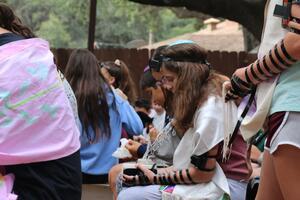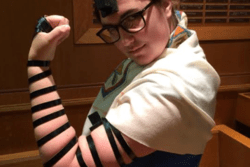On the Sanctity of My Tefillin
“Every time I wear my tefillin I feel like a grasshopper.”
This is what my mother said to me four years ago when I asked her why she doesn’t wear tefillin. Tefillin are leather boxes with Jewish texts inside that are wrapped around the left arm and head with leather straps during weekday morning services to fulfill a mitzvah (command). My mother, a rabbi, wears a kippah most of the time, so I was confused as to why she didn’t participate in the practice of wrapping tefillin as well. It was on my mind because that Sunday, the men’s club at my synagogue gifted beautiful new pairs of tefillin to my whole graduating Hebrew school class as part of their annual tradition.
The first time I put them on, I didn’t have a religious epiphany, but I did understand what my mother said. Well, sort of. I still don’t fully get it, but I think what she meant was that tefillin sit on your head like antennae. They messed up my hair. They were also uncomfortable: they made my arm fat bulge out between the tightly wrapped leather straps, and left marks when I took them off. The synagogue members around me assured me this would go away with use, and I was relieved. This never happened though; I only wore them once.
That summer, my first time at my happiest place on earth, Camp Ramah, I signed up for the tefillin-making workshop that was commonly referred to as a “once in a lifetime opportunity.” I’d heard that this workshop was not always open to girls; the man leading it was an Orthodox rabbi, and he’d previously adhered to the traditional Orthodox belief that women cannot wear tefillin, let alone make them. Even at my Conservative summer camp, only boys are required to wear tallit and tefillin because only they are so instructed by the Torah. Girls can if they want to, but I never did, because it is harder to force yourself when you are commanded by neither the Torah nor your counselors.
Being the feminist that I am, I took the class. Now, it might sound ridiculous that I would spend precious time at camp making something I do not use yet already own. But I was also curious about how tefillin were made. For two hours a day, three days a week for two weeks, I would sit with twenty other campers my age as the Orthodox rabbi led us through the strict and meticulous process of tefillin-making. To be honest, I don’t really remember very much about it. I know we painted something (animal skin?) black for the tefillin boxes that house the Torah scrolls; there was something with animal hairs (goat, I believe); and there were very tiny scrolls. What I do remember is that, in order for our tefillin to be kosher, everything we did had to be, according to the rabbi, “l’shem kedushas tefillin: for the sanctity of tefillin.” This blessing became our catchphrase, and before we began any work on our tefillin we were commanded to utter those Hebrew words, lest our tefillin be rendered invalid.
The day after we completed our tefillin and they were certified by the rabbi, I wrapped for the first time since that day at my synagogue with the men’s club. I remember feeling a stronger connection to the tefillin because I made them, and also because I knew that to some, by virtue of being female, my tefillin were not kosher or halakhically binding (pun intended), meaning that my wearing and making them was not in accordance with their interpretation of Jewish law. I think that made me even prouder: I wore them like I too was commanded.
That is why my tefillin are the perfect example of my Jewish identity. What could be more Jewish than wearing boxes of Torah on my body, especially when these boxes were made and primarily used at the place where I am my happiest and my most connected to Judaism? And what could be more feminist than doing something that is meaningful for you when many people think you should be excluded from it because of your gender?
I’m not going to lie; I only wear my tefillin at camp. And even at camp I struggle to put them on regularly: I am not forced to, they’re a lot of work to put on early in the morning, and most of the time I don’t connect to tefillin or prayer very strongly. But because I only wear them when I obligate myself, wearing tefillin feels all the more special to me.
A big part of my Jewish feminism is the reconciliation of and the meaningful connection between these two key parts of me: my feminism and my Judaism. My tefillin are the perfect example of this paradox, symbolizing the conflict between traditional Jewish practice and feminist belief. Yet the choice to immerse myself in this Jewish practice shows that my tefillin are not just feminist: they are an attempt to connect myself to my Jewish roots. Therefore, whenever I intertwine myself with my tefillin, figuratively and with its physical straps, with messy hair and Michelin Man arms, they remind me of my struggle with both Judaism and feminism, as well as my search for connection between the two different pieces of my identity.
This article was republished on Fresh Ink for Teens.
This piece was written as part of JWA’s Rising Voices Fellowship.







I love this. You are so marvelous!
Love this piece! And I love getting to learn from the Rising Voices Fellows with each of their posts!
So proud of you for venturing out of your comfort zone in such a meaningful way!
Good for you! This is such a unique piece and I think it's so cool that you made your own tefillin!